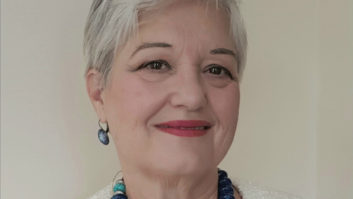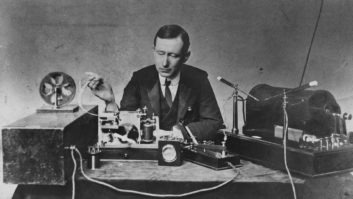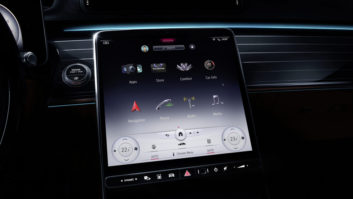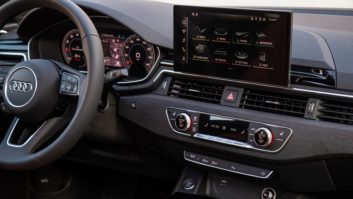(click thumbnail)Coming soon, Nokia’s N92 will allow subscribers to access live digital TV on the move.Your Standard or Mine?It seems that no new technology can evolve without a standards war, and mobile multicast media is no exception. Two key players have emerged: Digital Video Broadcast-Handheld, or DVB-H, and MediaFLO.
DVB-H was developed by Nokia and standardized by the European standards group ETSI. It will require a new chipset receiver tuned to whatever spectrum will be used for mobile video broadcasting. DVB-H delivers a downstream channel at high data rates that can be used either in standalone mode or as an enhancement of mobile networks. Battery life of the handheld is conserved by only switching on the front end of the receiver for short bursts of data, which are stored in a buffer. Material can be stored for later playout or delivered as live video streams. DVB-H is expected to be adopted by Cingular and T-Mobile, and is the most popular standard in Europe.
MediaFLO has been developed by Qualcomm, which has partnered with Verizon. Plans have been announced to launch a broadcast TV service in late 2006 or early 2007.
The technology was designed for efficient and economical distribution of the same multimedia content to millions of viewers simultaneously. The system is optimized for the best power consumption, frequency diversity and time diversity.
Both DVB-H and MediaFLO are “off-network” streams, with DVB-H operating in portions of the 174-230 MHz, 470-830 MHz and 1.452-1.492 GHz bands. MediaFLO will broadcast at 700 MHz, formerly UHF Channel 55.
Analysts say Verizon’s backing has pushed MediaFLO into an early lead in the emerging U.S. market.
DVB-H and MediaFLO are not the only standards under consideration. Digital Multimedia Broadcasting, or DMB, is being developed in South Korea, and the Japanese are hard at work on ISDB-T, or Terrestrial Integrated Services Digital Broadcasting.
All of these standards enable a one-to-many architecture, much like conventional TV. Signals will be distributed over a parallel network, so not to disrupt voice and data traffic. Subscribers needn’t worry about being victims of this standards war; both Samsung and LG electronics have already developed handsets that support both DVB-H and Media FLO.
– Tom VernonAs radio broadcasters become content providers for mobile devices, the need to think in terms of multimedia, rather than just audio, becomes increasingly important.
While the tiny display on most mobile phones might discourage long-duration viewing, wireless operators are anticipating a demand for material about breaking news and sports, as well as music videos. This demand is expected to escalate as more video-enabled handsets become available. Some analysts expect mobile to be the seventh mass medium after print, recordings, cinema, a radio, TV and the Internet.
Demand
The rollout of mobile video is expected to take place in two phases, Gerry Purdy, principal analyst for MobileTrax, said.
“First-generation video technology will entail narrowcasting, where a subscriber downloads content from the carrier’s server. The fee structure is pay-per-download. Users are not able to store material for later playback.” Verizon’s V-Cast network uses this model.
Purdy said the second-generation video will be streaming in a one-to-many model, much like today’s broadcasting. Initial offerings will be streaming only, after digital rights management issues are worked out, users will be able to record streams.
The second-generation model of “off-network” streams will be of particular interest to broadcasters, because with it, the cellular carriers will be using a conventional broadcast model for content distribution to subscribers, adding yet another competitor to the media jungle.
In some cases, the more conservative carriers have been slow to launch their own 3G content services, particularly in the United States. Several startup companies are partnering with carriers to deliver multimedia content to niche markets that the carriers themselves can’t reach.
Known as Mobile Virtual Network Operators, or MVNOs, they offer upscale mobile content such as music, videos and games, taking advantage of underutilized high-speed cellular networks.
There appears to be a demand for what the MVNOs are dishing up. In a recent survey by wireless research firm In-Stat, 80 percent of U.S. cellphone subscribers said MVNO-style targeted services sound appealing.
Answering the call are startup companies like Amp’d Mobile and Helio, along with established players like ESPN. All are targeting the tech-savvy, 18-34 demographic with a subscription-based business model offering music and videos.
Amp’d charges $30 to $200 per month, along with a one-time payment of $99 for its own branded phone. Helio is expected to have similar charges, while ESPN charges $35 to $225 per month for its services, as well as $200 for a branded phone.
Content trends
As it stands, many carriers now have fat pipes in search of content. Amp’d has partnered with Verizon, while both ESPN and Helio are running on Sprint’s high-speed network. The partnerships enable carriers to maintain their conservative image while reaching an edgier demographic. Amp’d Mobile’s pre-launch slogan, for example, was “Try not to die, Amp’d Mobile is coming” while Boost Mobile’s tagline is “Where you at.”
Other MVNOs are targeting global markets. Virgin Mobile is aiming for growth markets like China, India and South Africa. Many carriers in Europe and Asia have bypassed MVNOs and developed their own multimedia content, although many of the European operations run on slower connections.
Analysts at the Yankee Group estimate that the global market for MVNOs will reach $10.7 billion by 2010. Currently there are about 100 MVNOs in Europe, and about 20 in the United States, although a shakeout of the weaker companies is expected.
Purdy said mobile will be a brave new world for programming.
“Even if issues of handset battery life can be solved to enable longer duration streams, there will probably be a trend away from 30 minute and 1-hour programs. Broadcasters will experiment with new types of content with shorter duration. Instead of sponsored programs, we may see content with product placement.”
All of this mobile activity is occurring at a time when terrestrial radio is struggling to counter the mass exodus of younger listeners to satellite radio, the Internet and MP3 downloads.
Clear Channel has responded by offering clips of programming over cell phones. In addition to portions of originally produced programs, local weather and traffic information will be available for download. There are no plans to offer wireless access to music. John Hogan, Clear Channel Radio’s CEO said, “We have to fulfill our listeners’ request for what they want, when they want it.”













